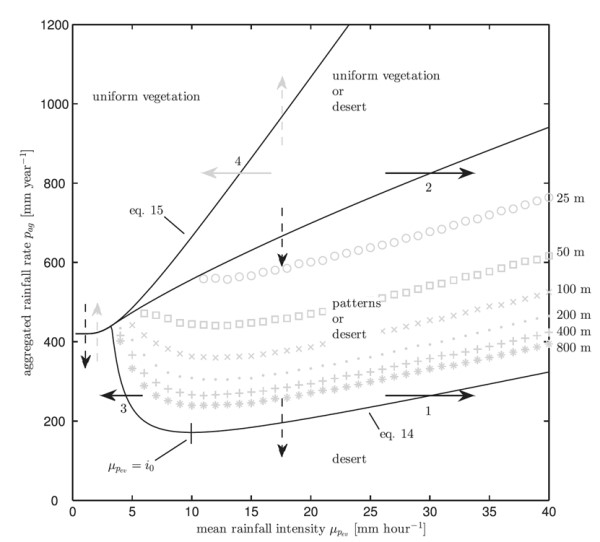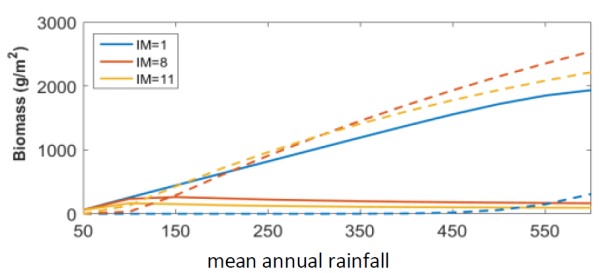| Contributing Authors: | Sonia Kéfi, Florian Schneider, Angeles G. Mayor, Alain Danet, Marina Rillo, Simon Benateau, Jacob Keizer, Ana Vasques, Susana Bautista, Paco Rodriguez, Alejandro Valdecantos, Jaime Baeza, Ramón Vallejo, Max Rietkerk, Mara Baudena, Mart Verwijmeren, Koen Siteur, Rubén Díaz-Sierra |
| Editor: | Jane Brandt |
| Source document: | S. Kéfi, A. Vasques, F. Schneider, M. Rietkerk, A.G. Mayor, M. Verwijmeren, R. Diaz-Sierra and M. Baudena. 2016. Response of Mediterranean drylands to increasing pressures. CASCADE Project Deliverable 6.1, 54 pp |
Global climate models consistently project upcoming changes in rainfall intensity in arid and semi-arid regions [3,90]. These changes in rainfall intermittency are projected with more confidence than possible changes in annual and seasonal rainfall volumes. As mentioned above, for the semi-arid Mediterranean area, an increase in meteorological drought frequency is predicted (medium confidence), together with an increase in heavy precipitation events (high confidence) [3].
Although hydrological models suggest that rainfall intensity and frequency both play a role in rainwater partitioning and lateral surface water redistribution, it is unknown if and exactly how the projected changes in rainfall intermittency are going to affect the productivity and functioning of semiarid ecosystems. Modelling the effect of changes in rainfall intensity on these ecosystems requires the coupling of processes that act on the time scale of a single rain event, with processes that act on much longer time scales, such as plant growth. Rainfall intermittency is fundamental to plant survival in drylands [91]. However, the current spatially explicit models, which capture vegetation self-organization in drylands, mostly represent rainfall as continuous in time, and thereby they do not explicitly deal with this issue ([92] but see [93,94]). Temporal stochasticity in rainfall pulses is also an important driver that has been suggested to explain the co-existence of plants competing for a single resource in drylands. However, no model study has explicitly investigated how competition for resources can lead to coexistence under realistic rainfall scenarios.
- Siteur et al. [95], addressed the role of changes in rainfall intensity for the response of self-organized vegetation spatial patterns in semiarid ecosystems.
- In Verwijmeren et al. [96], we studied the role of rainfall intermittency in the coexistence of plants with different strategies.
1. Effect of increases in rainfall intensity on semiarid ecosystems
Model description
We used a spatially explicit version of the water limitation model by Rietkerk et al. [97] that we coupled with a hydrological hillslope model that explicitly describes depth independent infiltration and infiltration excess (Hortonian) runoff generation on an event basis with simple conditional rules [95]. Rainwater partitioning and the runoff-runon processes are fast short-term processes that are modeled with event-based descriptions in the form of simple conditional rules. Temporal upscaling of the obtained infiltration rates yields a continuous formulation for infiltration, which is then used in the spatially extended version of the water-limitation model by Rietkerk and van de Koppel [98]. The full model acknowledges both processes that operate on short temporal scales, such as rainwater partitioning and redistribution, as well as processes that operate on longer temporal scales, such as plant growth.
Results
With the chosen parameter values, the model generates spatially periodic patterns in plant density along the hillslope. These so-called vegetation bands migrate in the uphill direction: colonization occurs directly uphill from the vegetation bands, while plant density slowly decays in the downhill part of the bands. This is in line with observations [99] and modeling studies [6], although fixed patterns have also been reported.
The model shows that an increase in mean rainfall intensity widens the rainfall range for which the ecosystem has alternative stable system states (Figure 1). We conclude that projected increases in rainfall intensity can induce and enhance bistability in semiarid ecosystems.

Changes in mean rainfall intensity can also induce a critical transition to a desert state or cause a recovery from a desert state, even if aggregated rainfall rates remain unchanged (Figure 1). Surprisingly, we found that, for a constant annual rainfall rate, both an increase and a decrease in mean rainfall intensity could trigger desertification. This finding was attributed to the fact that water can be lost from the system in two ways. During high intensity rain events, a fraction of the water flows through the vegetation bands and is lost as runoff, while during low intensity events a large portion of the water that precipitates over the bare interbands infiltrates locally, and gets lost due to soil evaporation and percolation without producing any run-off to the neighbouring vegetated bands
Conclusion
Our study suggests that changes in rainfall intensity may lead to increased resource losses, due to bare soil infiltration and runoff, and that these losses can potentially trigger desertification. This work suggests that in the future, field data could be used to assess the rainfall intensities that separate the different event types as identified in our model study. These values, combined with the frequency distribution of rainfall intensity, can be used to estimate the fractional loss of water from the system in current and future climates, and may thereby help in assessing the proximity of semiarid ecosystems to critical thresholds.
2. Effect of rainfall intermittency on species coexistence
Model description
The model adopted here describes the coupled dynamics of vegetation and soil moisture, and it is a combination and extension of the models presented by Baudena et al. [91] and Díaz-Sierra et al. [100]. Model assumptions and parameter settings are based on the experimental measurement performed in the CASCADE site of Santomera in South-Eastern Spain [101]. The model is spatially implicit, and water input in the model consisted of stochastic rainfall events based on statistics of historical data for the yearly amount and timing of rainfall. The model includes two plants: a relatively drought resistant plant, and a plant with a higher optimal growth rate, similar to the woody perennial species in the CASCADE site Artemisia herba-alba and Anthyllis cytisoides, respectively [96]. We provide a more detailed description of the model later (see »Including plant-plant interactions along drought and grazing gradients); the version of the model used here does not include grazing or facilitation.
We modelled realistic (stochastic) rainfall scenarios to explore the effect of rainfall intermittency on the co-existence of these two species.
Results
Our study shows for the first time that realistic, intermittent, rainfall can lead to co-existence under one single resource due to the differences in their optimal growth rate and wilting points, i.e. so-called relative non-linearity in growth (Figure 2). We showed that higher intermittency results in stable co-existence of the two species, whereas (nearly) constant rainfall leads to competitive exclusion of the species with higher growth rate by the more drought resistant species. With low intermittency, or nearly constant rainfall, the species with lower wilting point outcompetes the other species along the whole rainfall gradient, as the soil is never wet, whereas with increased intermittency the protégée can become dominant at nearly the whole rainfall gradient without outcompeting the nurse species.

Conclusion
This study shows that an increase in drought due to a changes in the temporal partitioning of rainfall (higher and less frequent events) can shift the competitive outcome of the two vegetation types, resulting in a shift in species composition from a drought resistant vegetation type to a coexistence of two vegetation types.
Note: For full references to papers quoted in this article see
